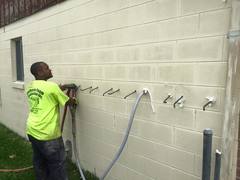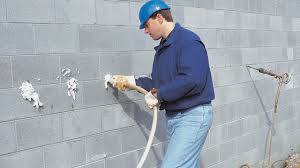Foam-in-Place Insulation
If you are a homeowner or business owner that is building a new home or new building then you may be wondering what type of insulation may be best for your project. This article will give you some information on foam-in-place insulation that you may not be aware of. There are two primary foam-in-place insulation types in the market today:
Masonry Foam and Spray Foam Insulation Advantages The best thing about foam insulation is that its high R-value makes it great for blocking heat transmission through walls and ceilings. It also has the ability to stop air infiltration through joints, cracks and other small openings in the structure of a home or building. This is a very important property of foam-in-place insulation, because it is estimated that up to 40% of wasted energy costs are due to air infiltration. Expanding foam is not only a good insulator but it is also great as an air-sealing barrier. When properly installed it creates a thermal envelope around the home or building that it is applied in. Spray-on or injectable insulation is also not as restricted as other types of insulation by the environment it is placed in. It easily goes around pipes, beams and other hard to reach places where batt type installation products have a hard time fitting into. |
|

R-value rating is often an issue when it comes to comparing different insulation products too. This makes it hard for people to judge accurately the comparison between the different types of insulation products that are available. For instance, many studies have shown that foam-in-place insulation products often have a much higher R-value than what they are actually rated at. And at the same time, research from the Department of Energy has shown that batt insulation products are often times rated 15% higher than the actual R-value they possess. So that disparity is a very important factor when comparing traditional fiberglass insulation with the improved technology of foam-in-place.
The following outlines some of the many benefits of foam-in-place insulation:
Most fiberglass and other batt styles of insulation only act as a blanket on your walls. They do not do such things as stopping moisture from getting through, and sealing air gaps in crevices, and it is in those areas that the energy losses take place. These are things that most types of foam-in-place insulations do very well.
The simple fact is that foam-in-place insulation offers a lot more advantages than most types of batt insulation.
For more information, please contact Southern Foam Insulation at 407-654-1251.
The following outlines some of the many benefits of foam-in-place insulation:
- Reduces noise
- Improves Air Quality
- Better Moisture Control
- Lowers Energy Costs
- Reduced carbon footprint (you'll be doing your part to easy your footprint on the environment)
Most fiberglass and other batt styles of insulation only act as a blanket on your walls. They do not do such things as stopping moisture from getting through, and sealing air gaps in crevices, and it is in those areas that the energy losses take place. These are things that most types of foam-in-place insulations do very well.
The simple fact is that foam-in-place insulation offers a lot more advantages than most types of batt insulation.
For more information, please contact Southern Foam Insulation at 407-654-1251.



